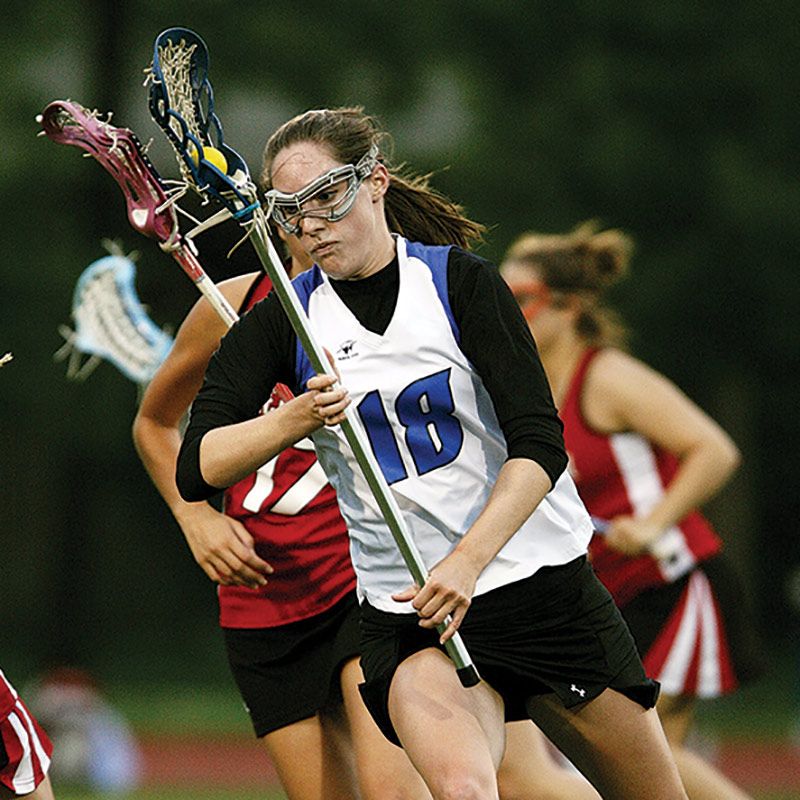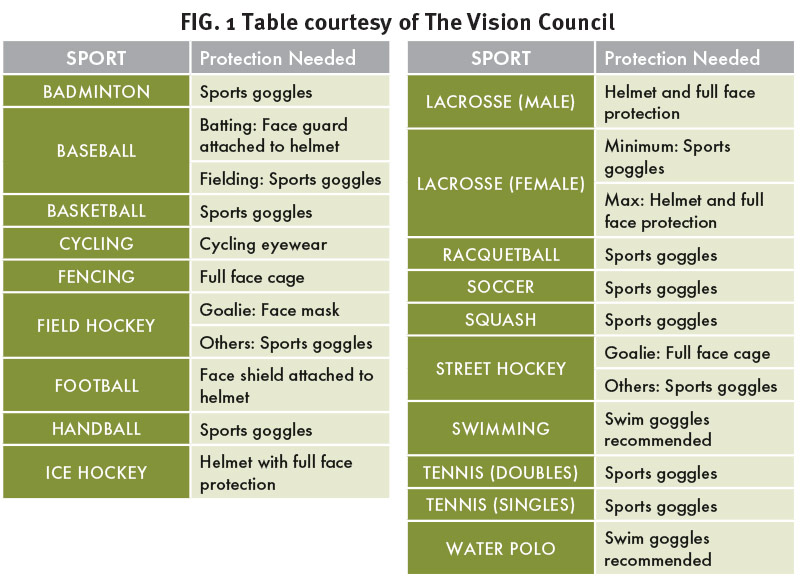
According to the American Academy of Ophthalmology, “Nearly 30,000 sports-related eye injuries are treated in U.S. emergency rooms each year. The good news is that 90 percent of serious eye injuries could be prevented by wearing appropriate protective eyewear.” Estimates are that one-third to nearly half of those injuries occur in children. But let’s stick to the good news—prevention.
Various sports have different risks to eye safety for adults as well as children, so let’s look at each of the most popular sports and the recommended protection (Fig.1).

Protection means that the eyewear, both lenses and frames, must meet rigorous standards for impact resistance. ASTM International, formerly known as American Society for Testing and Materials, is an international standards organization that develops and publishes voluntary consensus technical standards for a wide range of materials, products, systems and services. Sport eyewear falls under their purview. Each sport has its own code. This means the eyewear has been tested for protection in a particular sport. According to ASTM’s abstract on the Standard Specification for Eye Protectors for Selected Sports (F803), this specification covers eye protectors designed for use by players of racket sports, women’s lacrosse, field hockey, basketball, baseball and soccer that minimize or significantly reduce injury to the eye and adnexa due to impact and penetration by sport rackets and balls, lacrosse and field hockey sticks and balls, baseballs, soccer balls, hands, elbows and fingers.
Consider that balls used in sports are projectiles traveling at high speed. For example, the average speed of a lacrosse shot lies somewhere in the range of 70 to 80 miles per hour for the recreational lacrosse player. The average speed of a badminton shuttlecock is 201 miles per hour, and the average serve speed of a tennis ball is more than 60 miles per hour. It’s easy to understand that impact from a projectile at those speeds can inflict serious injury, so sport eyewear has to be strong, with high quality frame materials and polycarbonate or Trivex lenses.
In addition to protection, sport eyewear can enhance an athlete’s game. For athletes on the ski slopes or fishing enthusiasts, polarized lenses are a must. They help eliminate blinding light and reduce glare and reflections, allowing the athlete to see clearly. For baseball players or golfers, ultraviolet protection will improve visual clarity and contrast on a bright sunny day. Additionally, choosing the right lens color can make a difference and give the athlete a competitive advantage. Certain lens tints will enhance the athlete’s surrounding colors, while others can distort them. Golfers, for instance, should use brown and amber tints, which increase depth perception and enhance contrast. Counterintuitively, polarized lenses are not recommended for golfers because they affect a player’s depth perception, which can lead to a very sad day on the course. Mirror lenses help reduce glare while making any athlete look sharp and see sharp. But remember that sport eyewear isn’t worn only in the sun. Indoor sports require clear or lightly tinted lenses, and athletes who play under variable light conditions outdoors may benefit from photochromic lenses.
Sport eyewear easily combines function, comfort and fashion. Colorful high-tech frames with interchangeable lenses and comfort and ventilation features make sport eyewear appealing to children and adults for looks as well as protection. And for those who require vision correction, digitally optimized lens manufacturing techniques have expanded Rx range and field of view in 8-base sport frames. For higher prescriptions that might make edge thickness a problem in a wrap frame, behind-the-lens inserts are available for a number of frame styles. When fitting sport eyewear, the lenses should follow the shape of the face without resting on the patient’s cheeks. The temples should gently but firmly hug the sides of the head. For sports that require a helmet, make sure the preferred sport frame fits comfortably under the helmet.
Our patients are athletes of all ages who are passionate about a variety of sports, but they have one thing in common—the need for sport glasses. If you aren’t an expert on sport eyewear, now is the time to become one. A selection of sport eyewear for safety, function, comfort and fashion customized for each patient’s sport and visual needs gives ECPs a great competitive edge.













